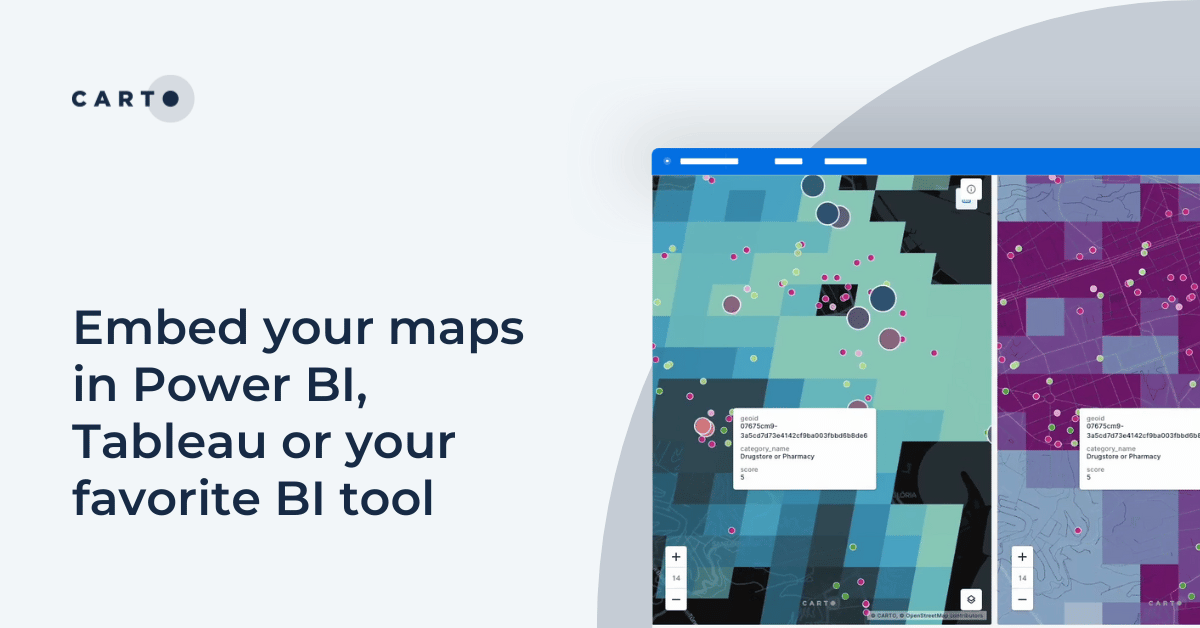Maps with a Mission: Environmental Impact with Spatial Analytics
.jpg)
This Earth Day, we're celebrating organizations that use the power of spatial analytics to create a positive environmental impact. Let’s dive into how these innovators use CARTO to protect biodiversity, advance climate research, manage natural resources, and drive sustainable decision-making. Read below to learn more about the following stories:
- NetCarbon: Using Satellite Data to Fight Climate Change
- Beyond Our Shores Foundation: Protecting Marine Ecosystems Through Fish Migration Tracking
- Protecting Marine Ecosystems Through Fish Migration Tracking
- Catalan Ornithological Institute: Crowdsourcing Bird Data for Conservation
- Junta de Andalucía: Making Climate Change Visible for Public Action
- AJW: Accelerating the Clean Energy Transition
- Mediterranean Donors: Transparent Grantmaking for Regional Impact
- National Renewable Energy Laboratory (NREL): Modernized Geospatial for Renewable Energy Solutions
Climate-focused scale-up NetCarbon is tackling CO2 emissions by transforming satellite imagery into actionable carbon insights.
NetCarbon provides real-time visualization of carbon storage across landscapes by analyzing more than 10 terabytes of satellite data directly from their BigQuery data warehouse. Their platform uses CARTO to help farmers, territories, and project owners measure and improve carbon sequestration.
With CARTO, NetCarbon are able to seamlessly scale geospatial workflows while delivering highly interactive and visually intuitive outputs - essential for translating complex carbon data into actionable strategies.
Read more about Netcarbon’s story here.

Beyond Our Shores Foundation operates an international tagging program for Mahi-Mahi (dolphinfish) that is revolutionizing how we understand this important fishery. The foundation collects crucial data for fisheries management and fishery research by tracking tagged fish and providing real-time maps on their website.
Their work provides insights into migration patterns, habitat use, and population dynamics — all essential for developing sustainable fishing practices and marine conservation strategies. The use of CARTO to create dynamic, web-based maps with real-time data layers, makes it an ideal platform for engaging both scientific and public audiences in marine conservation efforts.
Check out their interactive mapping tools at Regional Dolphinfish Reports and FAD Positions to see their research in action.
The EuroBirdPortal (EBP), coordinated by the Catalan Ornithological Institute (ICO) on behalf of the European Bird Census Council (EBCC) empowers citizen scientists to protect bird populations through collaborative mapping and data collection. This innovative project uses CARTO to transform millions of bird observations, from systematic surveys to more casual sightings, into comprehensive biodiversity insights that inform conservation efforts.
By combining the data submitted to all the online bird recording portals operating in Europe, EBP creates a constantly updated picture of bird distribution and migration patterns across the continent. This spatial data helps identify critical habitats, monitor population changes, and detect early warning signs of environmental disturbance.
CARTO’s user-friendly platform and support for large-scale data integration allow EBP to seamlessly visualize citizen-sourced data at a continental scale without sacrificing performance, clarity, or detail.

The Climate Center at Colorado State University has created CoCoRaHS (Community Collaborative Rain, Hail and Snow Network), an innovative citizen science initiative that gathers crucial precipitation and weather information across communities.
The environmental impact extends beyond data collection—CoCoRaHS builds climate literacy and STEM education while providing essential meteorological data to researchers, disaster response teams, and watershed managers. This collaborative approach to environmental monitoring creates a more complete picture of our changing climate patterns.
CARTO's intuitive mapping interface allows CoCoRaHS to easily transform decentralized citizen inputs into meaningful, accessible visualizations that support decision-making across scientific and public domains.
Explore their citizen science platforms at CoCoRaHS Maps.
In Spain, the government of Andalusia is tackling climate change head-on with an intuitive visual tool that makes complex climate data accessible to all citizens. Their Climate Map of Andalusia uses CARTO to demonstrate climate change impacts across the region, transforming abstract climate science into concrete information that citizens and policymakers can use to inform decisions.
By raising awareness about local climate impacts through CARTO’s visual storytelling tools, the maps drive climate action initiatives and support the region's agricultural sector in adapting to changing conditions.

Consulting agency AJW is leveraging CARTO to drive transformation in clean tech, energy, and environmental sectors. By using CARTO’s spatial modelling suite and intuitive visualization platform, they help clients understand complex spatial relationships in urban planning, transportation, and environmental sensitivity.
The environmental impact is tangible: AJW's maps facilitate solar energy deployment planning, identify optimal locations for renewable energy infrastructure, and support community benefit plans that balance development with environmental protection, accelerating the transition to cleaner energy systems and more sustainable communities.
The Mediterranean Donors Conservation Grant Tracker is an initiative that brings transparency to environmental projects through innovative grant mapping across the Mediterranean region. Their interactive tool uses CARTO to visualize over 700 grants, allowing stakeholders to track funding flows and identify regional patterns in environmental conservation, cultural preservation, and sustainable development initiatives.
By filtering projects by type or geographic area, users can discover connections between funding sources and regional outcomes that might otherwise remain hidden. This spatial approach to grant management improves reporting and helps identify funding opportunities for collaborative conservation efforts across the Mediterranean basin.
Check out the Mediterranean Donors Conservation Grant Tracker here: https://mediterranean-tracker.carto.solutions/
The National Renewable Energy Laboratory (NREL) is leveraging CARTO's spatial analytics capabilities to revolutionize renewable energy planning and emergency response systems.
The environmental impact extends across multiple fronts: NREL's spatial models estimate renewable energy production potential across different landscapes, helping identify optimal locations for wind farms, solar arrays, and transmission routes while minimizing ecological disruption.
With CARTO’s advanced spatial analysis tools and cloud-native architecture, NREL can efficiently process vast geospatial datasets while delivering responsive, interactive outputs to diverse stakeholders.
Hear more about NREL’s work:
These organizations demonstrate that spatial analytics isn't just about making beautiful maps, it's about creating tools that drive meaningful environmental action. As we celebrate Earth Day, these projects remind us that understanding our planet's complex systems begins with visualizing the connections between human activity and natural processes.
By making environmental data more accessible, actionable, and engaging, these CARTO users are helping to preserve and protect our planet for future generations.
Are you working on an environmental project? Book a meeting with our experts to see how you can benefit from spatial analytics!











.png)



